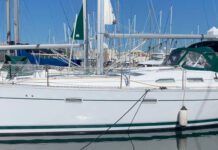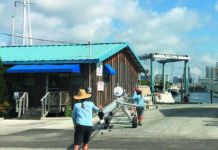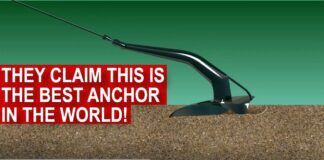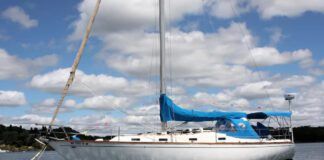Electric Outboards I have a Pearson Ensign 1962 now at a slip in New Rochelle, N.Y. This season marked the first time we had the luxury of keeping our boat at a slip. In order to maneuver through the marinas byways without worrying, I bought a 24-volt Minn Kota outboard (80 pounds of thrust) and two 12-volt batteries, which I hook up in series. Not only am I able to stop start, turn, etc., in the marina, but-to my surprise-in the calm sound water, I can nip along at about 3-4 mph with myself, two crew, and the 3,000-pound boat. The result is that Ive only used my 5-horsepower Mercury outboard once this year. My electric outboard doesn’t stall; it has variable speed like no ones business; reverses with relative ease, and is less expensive-though more cluttered-than the self-contained electric outboards you recently reviewed. Am I part of a 288 growing trend or just weird? If the former then it might be worthwhile testing electric outboards for boats my size (22.5 feet) and commenting on their applicability. My one negative experience was going out when we had a spate of wind coming unblocked from the northeast, wave heights were high, winds were over 20 mph, and the motor almost got torn off by a wave. So, its not something I would use in rough conditions, but those are not often, and I have my regular outboard onboard. Jed Shivers, We had a surprising amount of reader response to a short article we ran in the Nov. 15, 2004 issue regarding using a Minn Kota Riptide trolling motor as auxiliary power for a dinghy. As it turns out, many readers use trolling motors on dinghies and even as primary propulsion on boats in the size range of your Ensign. (The Riptide we tested is still alive and well, doing duty on a 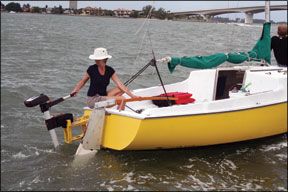
GR8M8S, Pearson Ensign
Scarsdale, N.Y.
FYI on DSC
Your sidebar on Digital Selective Calling and the need to get an MMSI (“Some Answers to the Most Frequently Asked DSC Questions,” October 2009) was excellent, but it missed an important point. MMSIs are issued by the Federal Communication Commission (FCC) only in conjunction with a ships station license, which costs $160 and must be periodically renewed. Recreational vessels that carry no more than VHF, radar, and EPIRBs (ie, no single-sideband rig) are not required to have a ships station license while operating in U.S. waters.
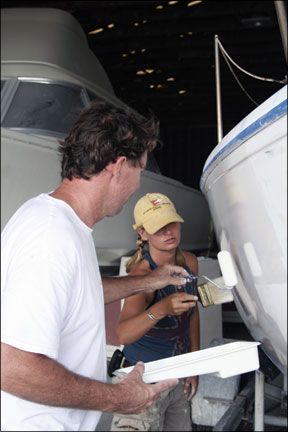
288
Boat/US, the Power Squadrons, and SeaTow have struck a deal with the FCC to issue MMSIs for free. These MMSIs are, however, specially coded so they can be recognized as “US-only” MMSIs. As you note, thats why one must get an MMSI directly from the FCC-along with a ships station license-if planning to operate outside U.S. waters.
Luther Abel,
Indulgence, CS 36
San Jose, Calif.
Dinghy Pumps
Great article on the V-bottom inflatable dinghies (November 2009), but one can wear out ones foot pumping these boats up. How about a recommendation on an electric inflator? We are, as a group, not getting any younger you know!
Lee Licata,
Izmir, Turkey
The floors of these boats have to be filled to about 11 psi (750mB), and to get that without breaking a sweat, youll need a high-pressure pump. We have not yet tested any high-pressure inflators, but our last dinghy pump test (June 2008) tapped the Rule ID20 as the Best Choice in 12-volt pumps. Since then, however, one of our two test models has stopped working, so it has fallen from our favor. We turned to major dinghy sellers (and competitors) West Marine and Defender for input, and both recommended the Bravo Superturbo BST 12 HPP from Scoprega. Like the Scoprega Bravo 12 we tested, this pump can be set to a certain cut-off pressure. If it screams as loud as the Bravo 12 we tested (105 dB), youll want earplugs. Weve also used a cheap ($20) 12-volt inflatable bed/car tire inflator from Target (fitted with the closest adapter). It works for the initial fill, but youll still need to manually bring the dinghy up to full pressure.
Hull Paint: Light vs. Dark
Too much fear is instilled in the boating industry about self-help in hull painting. I thought your article on this topic (November 2009) was timely and useful. However, not all of us want a white or black hull, but many are fearful of the harm to the hull should we decide to paint it a different shade. All know that a black hull will attract heat so as to make the hull almost not inhabitable, but what about other colors? How does a lighter shade of blue impact a hull? What happens to the fiberglass?
Tom,
Alden Challenger
Jacksonville, Fla.
Heat in the cabin is only one worry when you paint a boat a darker color. If it is an older boat (pre-1990s) built with a high-styrene content resin, there may be uncured resin in the hull that, due to the effects of heat-induced expansion and contraction cycles, will reveal print-through (the fabric pattern) in the hull. A lighter color is generally less likely to cause print-through or to reveal this effect.
Another problem with painting a white hull with any color, light or not, is that the inevitable nicks become more obvious. That lovely painted pale blue hull probably wont look so lovely two years later. Then again, if the boat is kept on a mooring and well cared for, it wont get the bumps and scrapes that are inevitable at the dock.
Exhaust Fumes
I have a Grampian 30. Several years ago, the exhaust manifold on the diesel came adrift, and the cabin filled with exhaust fumes. We changed the cushions and sprayed all type of chemicals. Nothing worked. The smell is still there. Is there a solution for this?
Hans Nita,
Boondoggle ll, Grampian 30
Toronto, Ontario
Our Practical Sailor
Advisor sections in the April and May 2007 issues suggested that time, a good bilge cleaner, and a hot-water pressure wash works for diesel spills, but we could find nothing in our files on soot, a potentially more insidious contaminant. Not knowing the degree of contamination, we assume it is very bad. Conveniently, Good Old Boat magazine, www.goodoldboat.com has an article in the October issue on a fire-damaged boat that could be helpful to you. The author, a victim of an onboard fire, used cleaning products from QuickNBrite (www.quicknbrite.com), Winsol Laboratories in Seattle (www.winsol.com), and Servpro Cleaning Co. (www.servpro.com). Another alternative would be hiring a professional cleaning service like Servpro to tackle the smells.Tillerpilot Trials
“Tillerpilot Sea Trials,” June 2009, compared a Raymarine ST1000 Plus ($449) to a Simrad TP10 ($305). You compared apples to oranges. You should have compared the Raymarine to the Simrad TP22 ($426.95, Marine-Electronics-Unlimited). I use the TP22 on my Hydrovane self-steering as a backup autopilot/emergency rudder setup. My hull is steel, so it receives the more accurate NMEA 0183 heading sentences from my KVH fluxgate compass. The TP22 controls the Hydrovane perfectly and steers my 24,000-pound Folkes 39-foot steel-hull cutter better than I could.
Scott Ritchie,
Loon-Asea, Folkes 39
Seattle, Wash.
We will be sure to include the TP22 in our next round of comparisons. Users who combine the tillerpilot with windvanes while motoring should know that prop-wash can result in vibration that can, over time, weaken welds on the mount or vane on some designs. If you have any doubts about your vane/tillerpilot setup, you should check with the vane maker to be sure your installation is adequate for this sort of duty.
Marine Holding Tanks
I have been looking for information in the back issues concerning waste holding tanks. My 2002 Jeanneau 43DS has two stainless-steel holding tanks that have very small pin holes and streaks of staining around the seams at the top of both tanks. Is this something that requires tank replacement or repair? How could they be repaired? Or what would be a better material for the tanks: plastic, aluminum? Im looking for the best solution, not the cheapest.
Jerry L. Boyarsky,
Via e-mail,
Closter, N.J.
A welder could fix these holes. Also, with the right prep work, epoxy products like System 3s Metal Weld, West Systems G-Flex, or Marine-Tex should plug pinholes. However, none of these fixes will eliminate the cause, and theres a chance there are other unseen and more troublesome leaks “below the waterline,” so to speak. The chemicals and acids that wind up in holding tanks can have a corrosive effect on metals, particularly welded seams, making stainless steel and aluminum less than ideal for holding tanks. In our view, the “best solution” is a new custom-made FRP/composite tank using isopthalic polyester or, even better, epoxy resins. If you are handy with epoxy, you can build a composite or solid FRP tank. A well-constructed epoxy coated plywood tank (FRP-taped and epoxy bonded at the seams) is also a viable option. A store-bought well-made plastic tank (Sealand did best in our September 2000 test), is another cost-effective solution for someone who doesn’t have the time to build his own tank.





